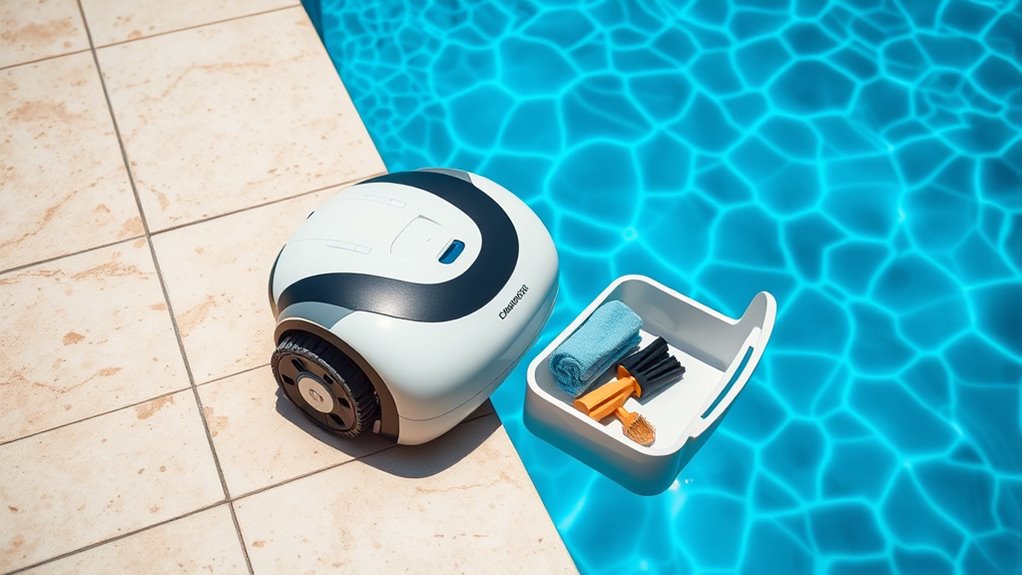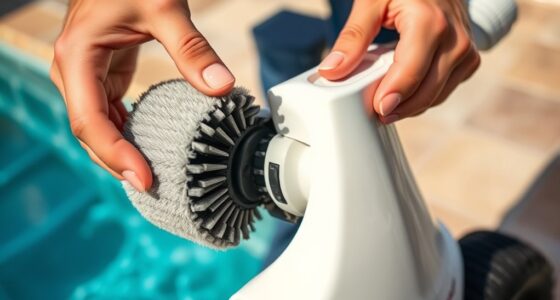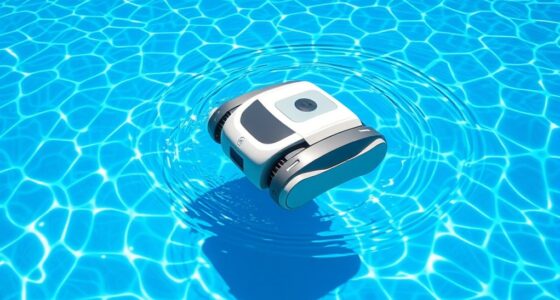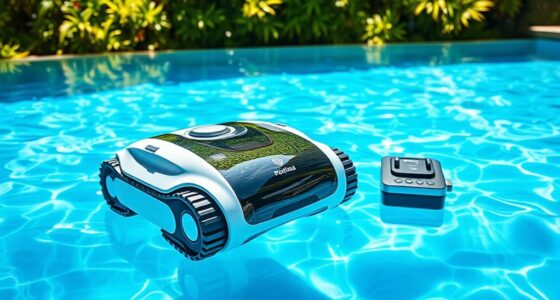To clean your robotic pool cleaner, regularly remove and rinse the filter, check brushes and scrub pads for wear, and clear debris from wheels and tracks. Store it in a cool, dry place when not in use, ensuring it’s completely dry beforehand. If the battery is removable, take it out and store it in a cool, partially charged state. Proper maintenance and storage help keep your cleaner running smoothly season after season—more tips await you.
Key Takeaways
- Remove and rinse the filter thoroughly with a garden hose to eliminate dirt, debris, and algae build-up.
- Clean or replace brushes, scrubber pads, and remove debris from wheels and tracks regularly.
- Ensure the cleaner is completely dry before storing in a cool, shaded area away from sunlight and moisture.
- If removable, take out the battery and store it in a cool, dry place, partially charged at around 50%.
- Follow manufacturer guidelines for storage and maintenance to prolong your robotic pool cleaner’s lifespan.

Keeping your robotic pool cleaner in top shape guarantees it performs efficiently and lasts longer. To achieve this, regular maintenance is essential. One of the most effective maintenance tips is to clean the filter regularly. Remove the filter from your cleaner and rinse it thoroughly with a garden hose to eliminate dirt, debris, and algae build-up. This prevents clogs and guarantees optimal suction power. Additionally, check the brushes and scrubber pads for wear and replace them if they’re worn out or damaged. Keeping the brushes in good condition helps your cleaner scrub the pool surface more effectively. Don’t forget to inspect the robot’s wheels and tracks, removing any debris or hair wrapped around them. Clearing out these obstructions prevents motor strain and improves mobility. It’s also wise to examine the power cord for cuts or frays and replace it if necessary to avoid electrical hazards. Regularly checking the air filtration system ensures the cleaner maintains optimal air flow and suction, extending its lifespan. Proper component maintenance can significantly enhance the device’s overall performance and durability, inspired by best practices for home equipment. Incorporating proper maintenance practices can significantly enhance the device’s overall performance and durability.
When it comes to storage solutions, proper storage is just as vital as maintenance. After each cleaning session, make sure your robotic pool cleaner is completely dry before storing it. Moisture can lead to mold growth or damage internal components. Store your cleaner in a cool, shaded area away from direct sunlight, which can degrade plastic parts and weaken the battery over time. If your model has a dedicated storage bag or stand, use it—these are designed to protect the device from dust and physical damage. If not, find a clean, dry space where the cleaner won’t be knocked over or exposed to extreme temperatures. Avoid leaving your robotic pool cleaner in the pool or on the pool deck for extended periods, especially during the off-season. Instead, remove it from the water, rinse off any residual pool chemicals, and store it indoors. This prevents corrosion and prolongs its lifespan.
In addition, consider removing the battery if your cleaner has a removable one, especially if you won’t be using it for an extended period. Store the battery in a cool, dry place and ensure it is partially charged—around 50%—to maintain its health. If your model doesn’t have a removable battery, just ensure the entire unit is stored in a protected environment. Proper storage solutions safeguard critical parts and make your next cleaning session easier. By following these maintenance tips and selecting the right storage solutions, you keep your robotic pool cleaner in excellent condition, ensuring it works efficiently season after season. Regular upkeep and thoughtful storage are simple steps that extend your device’s lifespan and keep your pool sparkling clean without unnecessary hassle.
Frequently Asked Questions
How Often Should I Replace the Brushes on My Robotic Pool Cleaner?
You’re wondering about brush replacement frequency for your robotic pool cleaner. Typically, you should replace the brushes every six months to a year, depending on usage and wear. Regularly inspect brushes for signs of damage or buildup. Following these cleaner maintenance tips guarantees peak performance and longevity. Staying on top of brush replacement helps maintain effective cleaning, prevents damage, and keeps your pool sparkling clean.
Can I Leave the Robotic Cleaner in the Pool During Rain?
Imagine your robotic pool cleaner gliding gracefully through your pool’s shimmering waters. Leaving it in during rain isn’t recommended because of rain protection concerns and electrical safety risks. Rain can cause electrical components to short-circuit or malfunction. For safety and peak performance, it’s best to remove and store your cleaner when storms threaten. Protect your investment by ensuring it stays dry and safe from electrical hazards.
What Should I Do if My Cleaner Gets Stuck on the Pool Wall?
If your robotic pool cleaner gets stuck on the pool wall, first stay calm. Gently lift it and check its pool wall navigation and obstacle avoidance features. Adjust its position or remove any debris blocking its sensors. Make sure it’s properly aligned for better wall navigation. Regularly inspecting and maintaining these features will prevent future issues, ensuring smooth cleaning and avoiding getting stuck again.
Is It Safe to Use a Robotic Cleaner on All Pool Surface Types?
You might wonder if your robotic cleaner is safe for all pool surface types. Generally, robotic cleaner safety depends on the pool surface compatibility. Most models work well on concrete, vinyl, and fiberglass, but check your manufacturer’s guidelines to guarantee your cleaner is suitable. Using the right cleaner for your pool surface prevents damage and ensures effective cleaning. Always verify surface compatibility to keep your robotic cleaner functioning at its best and safely.
How Do I Troubleshoot Connectivity Issues With the Remote Control?
When facing remote control troubleshooting, start by checking the batteries and replacing them if needed. Verify there’s no interference or obstructions blocking the signal, and keep the remote within the recommended range. For connectivity maintenance, reset your robotic pool cleaner and re-pair it with the remote if necessary. Regularly update firmware if updates are available. These steps help maintain a strong connection, making your pool cleaning experience smooth.
Conclusion
Now that you know how to properly clean and store your robotic pool cleaner, you’ll keep it running smoothly for years to come. Regular maintenance might seem like a hassle, but it’s worth it in the long run. Remember, a stitch in time saves nine—taking care of your cleaner now prevents bigger problems later. Keep up with these simple steps, and your pool will stay sparkling, making your summer days worry-free.









